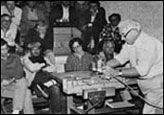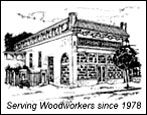|
|
The Woodturning Lathe: A Brief History
by Elena Vega
The lathe is among humanity's oldest and most
important machine tools. It can shape, drill, bore and grind. In
Turning and Mechanical Manipulation, Vol. I
,
John Jacob Holtzapffel terms the lathe 'the engine of civilization'. He points out it is unique
among machine tools in that not only is it the only machine capable of
replicating itself, but it is also capable of manufacturing all other
machine tools.
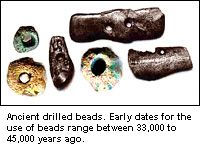
 The
lathe most likely evolved from the potter's wheel and the bow drill,
which may have been used to bore holes even before fire was discovered.
In fact, fire may have been accidentally discovered by someone trying
to drill a hole in a piece of wood. The presence of stone, shell,
ivory and bone beads with what appear to be drilled holes suggests
that the bow drill may have been used as early as the Late Stone
Age.
The
lathe most likely evolved from the potter's wheel and the bow drill,
which may have been used to bore holes even before fire was discovered.
In fact, fire may have been accidentally discovered by someone trying
to drill a hole in a piece of wood. The presence of stone, shell,
ivory and bone beads with what appear to be drilled holes suggests
that the bow drill may have been used as early as the Late Stone
Age.
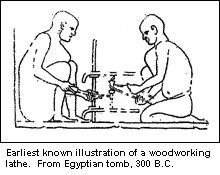
 The Egyptians are believed to be the first to use lathes, as
evidence of a round tenon joint was found in the tomb of King Tutankhamun
dating back to 1350 B.C. Moreover, the earliest known illustration
of a lathe is a drawing in an Eqyptian tomb dating back to 300 B.C. The drawing depicts one man holding a cutting tool while another
uses a cord to rotate the workpiece back and forth. The Egyptians
also developed the bow lathe which could be operated by one individual.
Two pointed pieces of wood supported the workpiece and a bow with
its string wrapped around the work was used to turn it. The turner
used one hand to move the bow forward and backward, while his foot
and other hand steadied the cutting tool. Cuts could only be made
on one-half of the motion, when the wood was spinning counterclockwise
toward the turner.
The Egyptians are believed to be the first to use lathes, as
evidence of a round tenon joint was found in the tomb of King Tutankhamun
dating back to 1350 B.C. Moreover, the earliest known illustration
of a lathe is a drawing in an Eqyptian tomb dating back to 300 B.C. The drawing depicts one man holding a cutting tool while another
uses a cord to rotate the workpiece back and forth. The Egyptians
also developed the bow lathe which could be operated by one individual.
Two pointed pieces of wood supported the workpiece and a bow with
its string wrapped around the work was used to turn it. The turner
used one hand to move the bow forward and backward, while his foot
and other hand steadied the cutting tool. Cuts could only be made
on one-half of the motion, when the wood was spinning counterclockwise
toward the turner.
The bow lathe soon gave way to the spring-pole
lathe, another type of lathe used by the ancient Egyptians. One
end of a rope was fastened to the end of a tree branch, extending
downward, making one turn around the workpiece. The lower end of
the rope was then tied to a loop that served as a treadle that the
turner pressed down with his foot to rotate the work. Although cuts
could still only be made while the wood turned in a counterclockwise
direction, the pole lathe was a definite improvement over the bow
lathe. It afforded a more rapid rotation and the turner now had
both hands free to hold the cutting tool.
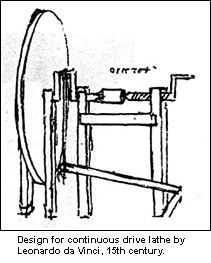
 Pole lathes continued to be used almost unaltered from about 500
B.C. into the late Middle Ages, until the inefficiency of its reciprocal
action led to the development of wheel-driven lathes. The wheel-driven
lathe provided continuous, controlled rotation in one direction.
This allowed constant cutting, permitting turners to be more precise
and efficient and enabled the use of harder materials. Leonardo
da Vinci was one of many to invent a continuous drive lathe, complete
with treadle, large flywheel, crankshaft, and a tailstock with hand-cranked
screw adjustment. Stuart King explains its operation in his article,
Short History of the Lathe
: "The crank, linked to the
treadle provided constant rotation whilst the momentum of the large
flywheel ensured the crank was carried over its 'dead spot'."
Pole lathes continued to be used almost unaltered from about 500
B.C. into the late Middle Ages, until the inefficiency of its reciprocal
action led to the development of wheel-driven lathes. The wheel-driven
lathe provided continuous, controlled rotation in one direction.
This allowed constant cutting, permitting turners to be more precise
and efficient and enabled the use of harder materials. Leonardo
da Vinci was one of many to invent a continuous drive lathe, complete
with treadle, large flywheel, crankshaft, and a tailstock with hand-cranked
screw adjustment. Stuart King explains its operation in his article,
Short History of the Lathe
: "The crank, linked to the
treadle provided constant rotation whilst the momentum of the large
flywheel ensured the crank was carried over its 'dead spot'."
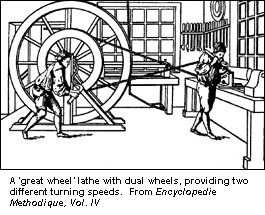
 For
heavy work the 'great wheel' was developed. The freestanding flywheels
were often six feet or more in diameter and were usually located
some distance away from the actual lathe. One or two men were employed
in turning the wheel, driven by a large cranked handle, while the
turner was left free to work. A connecting cord or belt turned smaller,
often stepped pulleys at the lathe and could be moved to select
from a number of available gear ratios.
For
heavy work the 'great wheel' was developed. The freestanding flywheels
were often six feet or more in diameter and were usually located
some distance away from the actual lathe. One or two men were employed
in turning the wheel, driven by a large cranked handle, while the
turner was left free to work. A connecting cord or belt turned smaller,
often stepped pulleys at the lathe and could be moved to select
from a number of available gear ratios.
In 1678 Joseph Moxon extolled the advantages of
the wheel-driven lathe in
Mechanick Exercises
:
"Besides the commanding heavy Work
about, the Wheel rids Work faster off than the Pole can do; because
the springing up of the Pole makes an intermission in running about
of the Work; but with the Wheel the Work runs always the same way;
so that the Tool need never be off it, unless it be to examine the
Work as it is doing."
Later versions of the wheel-driven lathe were powered
by animals. A mule or horse was hitched to the end of a pole running
out from a central shaft on an outdoor device. The animals walked
around and around, rotating the main shaft. With a series of heavy
gears, the central shaft greatly increased the speed while a smaller
shaft brought the power out through a housing on the ground. The
housing, connected to another heavy unit, caused a flywheel to spin
at high speed. As long as the mules or horses pulled the pole, the
pulley operated the device from a drive belt. If more power was
required, another animal was added. Other wheel-driven lathes incorporated
a water wheel rather than animals.
In 1769 Englishman James Watt sparked the Industrial
Revolution with his improved version of the steam engine. A few
years later, in 1774, another Englishman, John Wilkinson, modified
the lathe and patented a precision cannon-boring machine which made
efficient steam engines possible. The steam engine cylinder could
not be manufactured until machine tools capable of producing accurate
parts had been devised; the interior size of the cylinders had to
be precise so steam could not leak between the cylinder and piston.
Wilkinson's new boring machine provided the accuracy required for
the detailed measurements crucial to Watt's design.
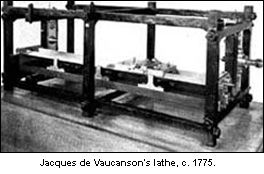
 In
1751, French inventor Jacques de Vaucanson built an industrial lathe
with an all-metal sliding tool carriage that was advanced by a long
screw. In 1797 Henry Maudslay in England and David Wilkinson (no
relation to John Wilkinson) in the U.S. almost simultaneously improved
upon de Vaucanson's lathe by adding a sliding tool carriage geared
to the spindle, enabling it to move at a constant speed in synchronicity
with the spindle. This allowed the cutting of accurate and repetitive
screw threads, permitting the production of identical parts necessary
for mass production techniques, as well as standardization of screw
threads and interchangeability of nuts and bolts.
In
1751, French inventor Jacques de Vaucanson built an industrial lathe
with an all-metal sliding tool carriage that was advanced by a long
screw. In 1797 Henry Maudslay in England and David Wilkinson (no
relation to John Wilkinson) in the U.S. almost simultaneously improved
upon de Vaucanson's lathe by adding a sliding tool carriage geared
to the spindle, enabling it to move at a constant speed in synchronicity
with the spindle. This allowed the cutting of accurate and repetitive
screw threads, permitting the production of identical parts necessary
for mass production techniques, as well as standardization of screw
threads and interchangeability of nuts and bolts.
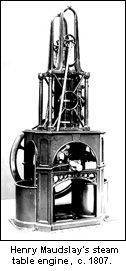
 Maudslay
further improved the lathe by incorporating the steam-powered engine.
The steam engine allowed large metal pieces to be worked much more
quickly and accurately. Patented in 1807, his compact steam table
engine - named after the form of the frame that supported the cylinder
- proved particularly useful in providing power to small workshops
and factories, as it did not require a separate engine house. It
was produced in large numbers in sizes varying from 1.5 to 40HP
by a variety of manufacturers until around 1850.
Maudslay
further improved the lathe by incorporating the steam-powered engine.
The steam engine allowed large metal pieces to be worked much more
quickly and accurately. Patented in 1807, his compact steam table
engine - named after the form of the frame that supported the cylinder
- proved particularly useful in providing power to small workshops
and factories, as it did not require a separate engine house. It
was produced in large numbers in sizes varying from 1.5 to 40HP
by a variety of manufacturers until around 1850.
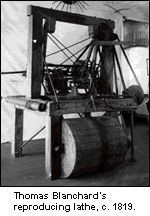
 In
1819 Thomas Blanchard developed a reproducing lathe for the mass
production of rifle stocks. A large drum turned a friction wheel
that traced the contours of a three-dimensional template and a cutting
wheel that followed the movements of the friction wheel to make
an exact replica of the pattern in wood. The lathe enabled an unskilled
workman to turn very complex and highly detailed shapes extremely
quickly, and to easily produce identical irregular shapes.
In
1819 Thomas Blanchard developed a reproducing lathe for the mass
production of rifle stocks. A large drum turned a friction wheel
that traced the contours of a three-dimensional template and a cutting
wheel that followed the movements of the friction wheel to make
an exact replica of the pattern in wood. The lathe enabled an unskilled
workman to turn very complex and highly detailed shapes extremely
quickly, and to easily produce identical irregular shapes.
The first successful internal combustion engine
was patented in 1860 by Jean Joseph Etienne Lenoir of Belgium, and
by the turn of the nineteenth century 'oil engines' were manufactured
in small units of adequate power to be used in small factories and
woodworking shops. As engines improved and became more reliable,
compact and affordable, they grew in popularity with individual
woodturners with small workshops.
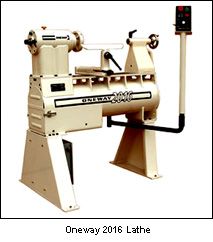
 By
the middle of the 20th century self-contained lathes with integral
electric motors were developed, making woodturning more accessible
to the hobby turner. Today models with variable-speed motors are
common, enabling speed changes without having to manually move the
drive belt onto different pulleys. In addition, production lathes
have evolved into computer-controlled machines of extreme precision,
capable of producing thousands of identical items a day in materials
ranging from balsa wood to titanium steel.
By
the middle of the 20th century self-contained lathes with integral
electric motors were developed, making woodturning more accessible
to the hobby turner. Today models with variable-speed motors are
common, enabling speed changes without having to manually move the
drive belt onto different pulleys. In addition, production lathes
have evolved into computer-controlled machines of extreme precision,
capable of producing thousands of identical items a day in materials
ranging from balsa wood to titanium steel.
Despite continued advancements
in technology throughout the centuries, however, the techniques
used to shape the wood remain the same. Consequently, the human elements of skill and talent are still required to create wooden spindles, bowls, vessels, figures, ornaments and other accessories.
Bibliography
Primary Sources
:
Darlow, Mike.
The Fundamentals of Woodturning
. Exeter: Melaleuca Press, 1997.
The Demesne of Dis Pater
, "On ye Art and Mysterie of Turning". <http://homepages.ihug.com.au/~dispater/turning.htm>.
Harris, James E. "A Brief History of Ornamental Turning". <http://ourworld.compuserve.com/homepages/jeharr/history.htm>.
Holtzapffel, John Jacob.
Hand or Simple Turning: Principles and Practice
. New York: Dover Publications, 1976. (Orig. pub. 1881).
.
The Principles and Practice of Ornamental or Complex Turning
. New York: Dover Publications, 1973. (Orig. pub. 1894).
.
Turning and Mechanical Manipulation, Vol. I: Materials, Their Choice,
Preparation and Various Modes of Working Them
. Mendham: Astragal Press, 1994. (Orig. pub. 1843).
King, Stuart.
Stuart King: Craftsman, Artist, Woodturner and
Photojournalist
, "Short History of the Lathe". <http://www.stuartking.co.uk/articles/lathe.htm>.
Lukin, James, ed.
Turning Lathes
. 4th ed. Mendham: Astragal Press, 1894.
MacGregor Historic Games
. <http://www.historicgames.com/lathes/lindex.html>.
Rainey, Nicholas.
Woodturning Resources
, "The History Of Woodturning". <http://www.woodturning-resources.co.uk/>.
Science & Society Picture Library
. <http://www.scienceandsociety.co.uk/results.asp?image=10280861>.
Secondary Sources
:
Daumas, Maurice, ed.
A History of Technology and Invention :
Progress Through the
Ages, Vol. II, The First Stages of Mechanization
.
New York: Crown Publishing Group, 1969.
Francis, Pete. "Bead Revolutions: The Role
of Beads in Technological Change". Lecture. Bead Expo 2000
Symposium, Santa Fe, 26 March 2000.
Moxon, Joseph.
Mechanick Exercises or the Doctrine of Handy-works
.
3rd ed. Mendham: Astragal Press, 1998. (Orig. pub. 1678).
Nicholson, P.T., and Shaw, I., eds.
Ancient Egyptian Materials
and Technology
. Cambridge: Cambridge University Press, 2000.
|
|


